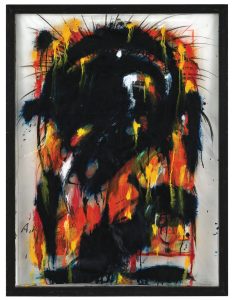
A singular œuvre that transcends image and painting: With his iconic Übermalungen and powerful self-portraits, Arnulf Rainer has cemented his place in both the Austrian and international art markets.
“TRRR”, reads the signature. Just “TRRR” – a moniker that exemplifies the provocative spirit of post-war artist Arnulf Rainer, who will be celebrating his 95th birthday in December 2024. Rainer has cycledthrough countless “isms” since 1945 and left an indelible mark on international art history, particularly with his Übermalungen (Overpaintings). Born in Baden bei Wien in 1929, the artist has earned his place on the world stage with numerous prestigious awards, repeated inclusions in documenta and the Venice Biennale, and retrospectives at the Guggenheim Museum in New York, Centre Pompidou in Paris and Stedelijk Museum in Amsterdam.
The “TRRR” signature adopted by the artist for his first Zentralgestaltungen (Central Compositions) in the late 1940s was intended to mimic the growl of a snarling dog. At the time, the self-taught artist – who had angrily left both of Vienna’s art academies – was still exploring the figurative style known as Phantastischer Realismus, or Fantastic Realism. Together with Ernst Fuchs, Anton Lehmden, Arik Brauer, Wolfgang Hollegha and Josef Mikl, Rainer was part of the so-called Hundsgruppe (dog group). They put on only one exhibition together, at the opening of which Rainer launched into a “verbal tirade” meant to offend the audience – a daring move in the conservative post-war era. The pivotal shift towards gestural abstraction came in 1951 during a stay in Paris, then a hotbed of avant-garde experimentation. Together with his partner, Maria Lassnig, Rainer discovered Surrealism and the emerging Art Informel movement, which dovetailed perfectly with his interest in automatism and spontaneous creation. It was during this period of intense experimentation that the artist produced highly concentrated blind drawings and what Rainer himself called “automatic scribble expressions”, which quickly gave rise to the single vertical and horizontal forms that would later characterise much of his work.
His Kreuze (Crosses) have their origins in this period.
Rainer arrived at his celebrated Übermalungen through a series of artistic evolutions – from Proportionscollagen (Proportion Collages) to his Reduktionen (Reductions) series, which is characterised by austere, monochrome black paintings with starkly delineated and geometric white elements. The works emerged from the process itself: “Out of dissatisfaction, I kept correcting the paintings until they became darker and darker. That’s how the Übermalungen started out, without any big concepts”, Rainer once said about his work. These works, he said, were born out of a “love of and urge for perfection”, but also out of a search for serenity beyond gesture, a sounding-out of the limits of picture support, colour and painting edge.
Since then, he has made many variations of these predominantly monochrome Übermalungen. The majority are black, some red, a few brown, and very rarely, blue. For Rainer, perfection was “the completely dark painting, filled with overwhelming silence”. This “dark, heavy calm”, as he described it, is something he is always trying to “experience, articulate, and suggest over and over again. With each new attempt, I try to discover fresh variations.” Early versions of these often untitled Übermalungen are now exceedingly rare and highly coveted by collectors. Rainer’s work attracted collectors from the outset, and his rise was swift. As Maria Lassnig cheekily remarked, he was one of Monsignor Otto Mauer’s “Stephan boys” – referring to the avant-garde artists associated with the progressive clergyman and his Galerie nächst St. Stephan. Rainer had his first solo exhibition there in 1955, at age 26.
Rainer, himself a collector of Art Brut, ventured into new territory in the mid-1960s, creating drawings under the influence of alcohol and LSD. The experimentation led him to explore body language and performance, producing wild oil paintings with his bare hands and reworking photographs of himself with his face twisted into exaggerated grimaces – very early, expressive “selfies”, as it were. The process began with photo sessions, after which Rainer would select images based on the “intensity of facial transformation and nervous tension” (Rainer). He then “graphically worked over” them, whereby the intensity of the physiognomic quality determined the speed of the graphic accentuation. By this time, his works were signed “A.R.” or “Arnulf Rainer”, but the rebellious spirit of that early “TRRR” was still very much alive – and was captured
all the same.
AUCTION
Contemporary Art I, 20 November 2024, 6 pm
Palais Dorotheum, Dorotheergasse 17, 1010 Vienna
[email protected]
Tel. +43-1-515 60-358, 386
















